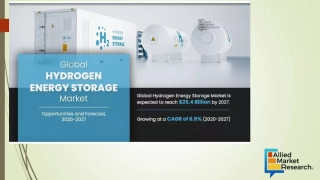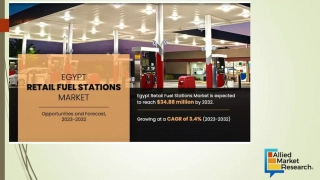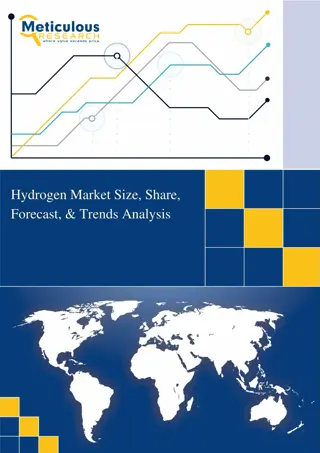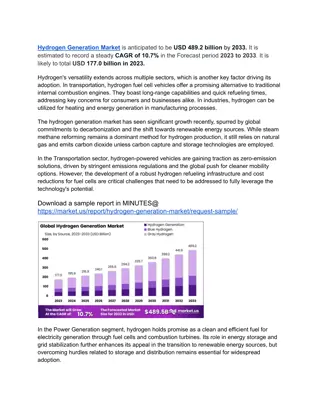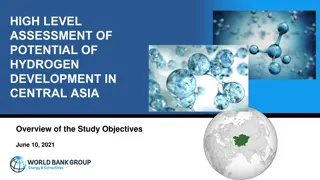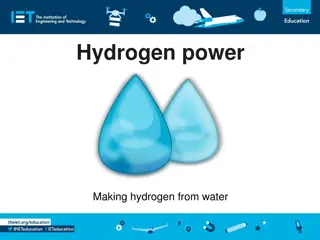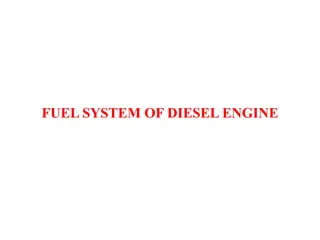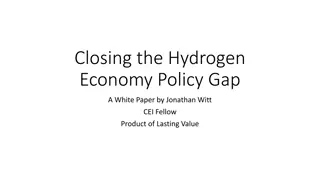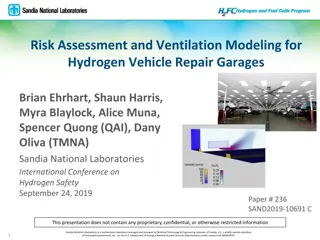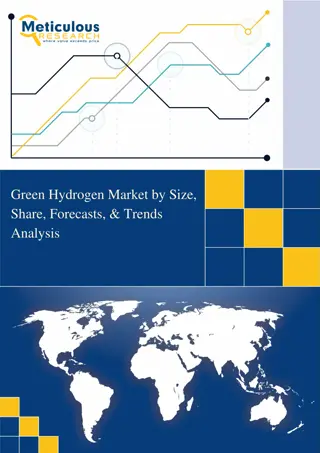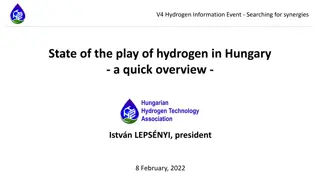Hydrogen Fuel Cell Vehicle Winter Testing in Poland
Poland, a major hydrogen producer in Europe, conducts operational tests of hydrogen fuel cell vehicles in winter conditions to ensure safety and efficiency. The tests, conducted on a Toyota Mirai car equipped with fuel cells, focus on operational safety at temperatures as low as -25 degrees Celsius. With instructions tailored for winter use, the aim is to prepare users for hydrogen-powered vehicles in cold climates. The research, undertaken at Cracow University of Technology, provides valuable insights for the adoption of hydrogen technology in the automotive industry.
Download Presentation

Please find below an Image/Link to download the presentation.
The content on the website is provided AS IS for your information and personal use only. It may not be sold, licensed, or shared on other websites without obtaining consent from the author.If you encounter any issues during the download, it is possible that the publisher has removed the file from their server.
You are allowed to download the files provided on this website for personal or commercial use, subject to the condition that they are used lawfully. All files are the property of their respective owners.
The content on the website is provided AS IS for your information and personal use only. It may not be sold, licensed, or shared on other websites without obtaining consent from the author.
E N D
Presentation Transcript
ICHS International Conference on Hydrogen Safety Hydrogen for the global market SEPTEMBER 24 -26, 2019 - Adelaide, Australia TESTS OF THE VEHICLE'S POWERTRAIN WITH HYDROGEN FUEL CELLS AT A LOW TEMPERATURE Szalek, Andrzej Toyota Motor Poland Company Limited, Warsaw Brzezanski, Marek Cracow University of Technology, Poland
Poland is one of the largest hydrogen producers in Europe. Up to 1 million tons of hydrogen is produced annually in the Polish chemical industry (mainly nitrogen plants) as well as in the energy and oil processing plants. Poland currently has almost 40 million inhabitants and is a large car market in Europe, where over 600,000 units are sold annually. A road transport electrification program is currently being introduced, including the use of hydrogen to power fuel cell vehicles. Before the launch of cars powered by fuel cells, operational tests of this type of vehicles were carried out. The purpose of these tests was to check the operation of hydrogen powered vehicles in local conditions, prepare users for their operation and check operational safety.
In Poland, the average temperature in winter is usually from about -2 degrees Celsius, while sometimes there are days when the temperature is lower than - 25 degrees Celsius One of the problems is the safe operation of hydrogen fuel cells during the winter
The first hydrogen fuel cell car produced in the world is the Toyota Mirai In countries where in winter the temperature is lower than 0 degrees Celsius, users receive instructions for using this car in winter. The Winter procedures contained in it differ from the use of conventional cars and have an impact on operational safety.
At preliminary vehicle was equipped with hydrogen- powered fuel cell drive. The object of the research was a Toyota Mirai car in a standard version, equipped with an electric drive system and fuel cells, supplied with hydrogen with a purity of 99.97% H2 stored under 700 bar pressure in two tanks made of composite materials. the Cracow University of Technology a These tests were carried out in an accredited thermoclimatic chamber that allows a quick change in the ambient temperature. The chamber with dimensions: 23.7x6.9x6.5 m, belonging to the Thermoclimatic Research Laboratory of the Cracow University of Technology, allows testing of various types of facilities, including temperature range from -50 to + 70 C. vehicles, in the
The purpose of this research was to gain practical experience from the winter operation of the vehicle, which have an impact on the safe operation of the hydrogen powered vehicle. Research on the Toyota Mirai car was conducted in a thermoclimatic chamber in the temperature range from -10 Deg.C to -18 Deg.C, which corresponds to the average temperature occurring in winter in the temperate climate zone in Poland. The vehicle was inserted into the chamber with an unheated link, and the test time was about 2.5 hours.
Measurements of many different physical quantities characterizing the operation of the drive unit were carried out, using signals available in the vehicle's on-board diagnostic system of Toyota. Particular attention has been paid to those parameters that have an impact on the operational safety of the drive system at a reduced temperature. The following parameters were measured: Measurement time Temperature in the thermoclimatic chamber, Hydrogen Pump Motor Temperature, Smoothed Value of Hydrogen Tank 1 Temperature, Smoothed Value of Hydrogen Tank 2 Temperature, FC Stack Coolant Temperature (FC Stack Outlet), Smoothed Value of FC Stack Coolant Temperature, FC Stack Coolant Temperature (Radiator Outlet), Smoothed Value of Intake Air Temperature, Smoothed Value of FC Stack Air Temperature, hydrogen pressure in high, medium and low pressure circuits.
Temperature of hydrogen tanks during vehicle tests in a thermoclimatic chamber
Temperature of the hydrogen pump during testing of the vehicle in the thermoclimatic chamber
Temperature of the cooling medium of hydrogen fuel cells and air in the cell segments during vehicle tests in the thermoclimatic chamber
Air temperature in the hydrogen fuel cell intake system during vehicle tests in the thermoclimatic chamber
CONCLUSIONS: The tests have initial character and are used to identify phenomena occurring during the operation of a powertrain equipped with a fuel cells fuelled with hydrogen. The tests were carried out in conditions of low ambient temperature, which are the least favourable for hydrogen fuel cell operation. The operation of the vehicle's power unit, equipped with hydrogen- powered fuel cells, in conditions of low temperature requires the use of new, special procedures that are not used in other vehicle powertrains. Particular attention has been paid to the elements of the hydrogen supply system, which during the tests at a reduced temperature were covered with a layer of condensed water. This phenomenon did not affect the safe operation of the vehicle.
Attention was also paid to the live electrical connections and systems, which were also covered with a layer of condensed water during the tests. In this case, there were also no disturbing symptoms. The research shows that the set of hydrogen composite tanks is well insulated, which translates into a slower change in the temperature of the tanks, in relation to changes in the ambient temperature. The largest temperature change occurs in all components of the drive system in which the flow of refrigerants occurs. These elements are most exposed to such changes as: thermal expansion of materials, loss of sealing properties or change of electrical conductivity, resulting from the coverage of their surface condensed by water vapour. Conclusions from the preliminary tests carried out can contribute to the development of operational indications and instructions for users of vehicles equipped with hydrogen fuel cells and for service stations servicing such vehicles.
ICHS International Conference on Hydrogen Safety Hydrogen for the global market SEPTEMBER 24 -26, 2019 - Adelaide, Australia TESTS OF THE VEHICLE'S POWERTRAIN WITH HYDROGEN FUEL CELLS AT A LOW TEMPERATURE THANK YOU FOR YOUR ATTENTION Szalek, Andrzej Toyota Motor Poland Company Limited, Warsaw Brzezanski, Marek Cracow University of Technology


